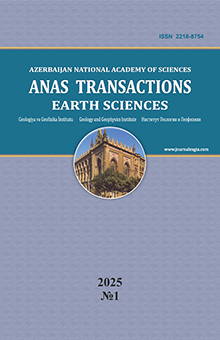№ 1,
2021
Download the article
Impact of nanoparticle structure on the effectiveness of Pickering emulsions for EOR applications
Oil gas scientific research project Institute, SOCAR H.Zardabi str. 88A, Baku, Azerbaijan, AZ 1122: E-mail: Baghir.Suleymanov@socar.az
Summary
A-
A+
Today, the amount of residual oil in the world averages more than 70% of the original geological reserves. With increasing number of mature oil fields, exploitation of these reserves becomes an important task. In this context, Enhanced oil recovery (EOR) techniques, represented by a wide range of modern technologies, are becoming more and more important year by year. The majority of implementations are occupied by physical and chemical EOR methods based on the injection of chemical compounds into formations. One of the most promising and effective technologies of mentioned methods is “oil-in-water” inverse emulsions. However, this technology has serious limitations for implementation in high temperature reservoirs. This issue requires development of new emulsion types which overcome these drawbacks. One of the promising technologies in this regard is so-called Pickering emulsions application. In this research Pickering emulsions composition stabilized by SiO2 nanoparticles had been obtained. The impact of nanoparticles structure was evaluated within the frame of emulsion stabilization. To this end, experiments were performed to determine the zeta potential, particle size distribution of the dispersed phase, rheological properties at different temperature conditions. Sand pack displacement experiments showed a high potential of oil recovery increase while practical implementation of the proposed compositions.
Keywords: Pickering emulsion, mesoporous nanoparticles, enhanced oil recovery, mature oilfields
REFERENCES
Aveyard R., Binks B P., Clint J.H. Emulsions stabilised solely by colloidal particles. Advances in Colloid and Interface Science, Vol. 100-102, 2003, pp. 503-546.
Binks B.P. Particles as surfactants-similarities and differences. Current opinion in colloid and interface science, Vol. 7, No. 1-2, 2002, pp. 21-41.
Dudchenko A.V., Rolf J., Shi L., Olivas L., Duan W., Jassby D. Coupling underwater superoleophobic membranes with magnetic pickering emulsions for fouling-free separation of crude oil/water mixtures: an experimental and theoretical study. ACS nano, Vol. 9, No.10, 2015, pp. 9930-9941.
Duffus L.J., Norton J.E., Smith P., Norton I.T., Spyropoulos F. A comparative study on the capacity of a range of food-grade particles to form stable O/W and W/O Pickering emulsions. Journal of colloid and interface science, Vol. 473, 2016, pp. 9-21.
Fortuny M., Oliveira C.B., Melo R.L., Nele M., Coutinho R.C., Santos A.F. Effect of salinity, temperature, water content, and pH on the microwave demulsification of crude oil emulsions. Energy and Fuels, Vol. 21, No. 3, 2007, pp. 1358-1364.
Green D.W., Willhite G.P. Enhanced oil recovery. Vol. 6. Richardson, TX: Henry L. Doherty Memorial Fund of AIME, Society of Petroleum Engineers. 1998, pp. 143-154.
Greenwood R., Kendall K. (). Selection of suitable dispersants for aqueous suspensions of zirconia and titania powders using acoustophoresis. Journal of the European Ceramic Society, Vol. 19, No. 4, 1999, pp. 479-488.
Xu Z.X., Li S.Y., Li B.F., Chen D.Q., Liu Z.Y., Li Z.M. A review of development methods and EOR technologies for carbonate reservoirs. Petroleum Science, Vol. 17, No. 4, 2020, pp. 990-1013.
Lee K.S. Performance of a polymer flood with shear-thinning fluid in heterogeneous layered systems with crossflow. Energies, Vol. 4, No. 8, 2011, pp. 1112-1128, doi:10.3390/en408111
Mansour A., Gamadi T., Emadibaladehi H., Watson M.. Limitation of EOR applications in tight oil formation. In SPE Kuwait Oil & Gas Show and Conference. Society of Petroleum Engineers. 2017, October.
Muggeridge A., Cockin A., Webb K., Frampton H., Collins I., Moulds T., Salino P. Recovery rates, enhanced oil recovery and technological limits. Philosophical Transactions of the Royal Society A: Mathematical, Physical and Engineering Sciences, Vol. 372, No. 2006, 2014.
Pickering S.U. CXCVI.– emulsions. Journal of the Chemical Society, Transactions, Vol. 91, 1907, pp. 2001-2021.
Samanta A., Bera A., Ojha K., Mandal A. (). Effects of alkali, salts, and surfactant on rheological behavior of partially hydrolyzed polyacrylamide solutions. Journal of Chemical & Engineering Data, Vol. 55, No.10, 2010, pp. 4315-4322.
Shafiai S.H., Gohari A. Conventional and electrical EOR review: the development trend of ultrasonic application in EOR. Journal of Petroleum Exploration and Production Technology, 2020, pp. 1-23, DOI:10.1007/s13202-020-00929-x
Sheng J.J. Critical review of field EOR projects in shale and tight reservoirs. Journal of Petroleum Science and Engineering, Vol. 159, No. 11, 2017, pp. 654-665.
Suleimanov B.A., Feyzullayev K.A., Abbasov E.M. Numerical simulation of water shut-off performance for heterogeneous composite oil reservoirs. Applied and Computational Mathematics, Vol. 18, No. 3, 2019a, pp. 261-271.
Suleimanov B.A., Ismailov F.S., Veliyev E.F. Nanofluid for enhanced oil recovery. Journal of Petroleum Science and Engineering, Vol. 78, No. 2, 2011, pp. 431-437.
Suleimanov B.A., Ismailov F.S., Veliyev E.F. On the metal nanoparticles effect on the strength of polymer gels based on carboxymethyl cellulose applying at oil recovery. Oil Industry, No. 1, 2014, pp. 86-88 (in Russian).
Suleimanov B. A., Latifov Y.A., Veliyev E.F. Softened water application for enhanced oil recovery. SOCAR Proceedings, No.1, 2019b, pp. 19-28 (in Russian).
Suleimanov B.A., Latifov Y.A., Veliyev E.F., Frampton H. Low salinity and low hardness alkali water as displacement agent for secondary and tertiary flooding in sandstones. In SPE Annual Caspian Technical Conference and Exhibition. Society of Petroleum Engineers, Baku, 2017, November.
Suleimanov B.A., Veliyev E.F., Azizagha A.A. Colloidal dispersion nanogels for in-situ fluid diversion. Journal of Petroleum Science and Engineering, Vol. 193, 2020, 107411.
Veliyev E.F. Review of modern in-situ fluid diversion technologies. SOCAR Proceedings, No. 2, 2020, pp. 50-66 (in Russian).
Yoon K.Y., Son H.A., Choi S.K., Kim J. W., Sung W.M., Kim H.T. Core flooding of complex nanoscale colloidal dispersions for enhanced oil recovery by in situ formation of stable oil-in-water pickering emulsions. Energy & Fuels, Vol. 30, No. 4, 2016, pp. 2628-2635.
DOI:
10.33677/ggianas20210100057
